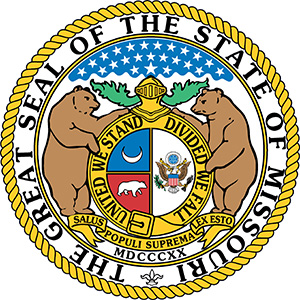 |
MISSOURI STATE SYMBOLS
STATE SEAL
Great Seal of the State of Missouri
|
On January 11, 1822, the General Assembly adopted an act providing for the Great Seal of the State of Missouri. The legislation specifically described the symbols on the seal and their placement. The Secretary of State serves as the official keeper of the Great Seal. A few variations have appeared over the last 200 years (see the photo gallery below), but the whole has remained the same.
The Great Seal was designed by Judge Robert William Wells. The center of the seal is composed of two parts. On the right is the United States coat of arms containing the bald eagle. In its claws are arrows and olive branches, signifying that the power of war and peace lies with the U.S. federal government. On the left side are a grizzly bear and a silver crescent moon from the Missouri coat of arms. The crescent symbolizes Missouri at the time of the state seal’s creation: a state of small population and wealth that would increase like a waxing crescent moon. It also symbolizes the “second son,” because Missouri was the second state formed out of the Louisiana Territory, just as a crescent moon is the second phase of the moon after "new."
The shield is encircled by a belt inscribed with the phrase, “united we stand divided we fall,” implying that not only should Missourians work together, but Missourians should work with all other states and the federal government. Two grizzly bears on either side of the shield symbolize the state’s strength and its citizens’ bravery. The bears stand atop a scroll bearing the state motto, “salus populi suprema lex esto.” (See the state motto page for more.) Below this scroll are the Roman numerals for 1820, the year Missouri began its functions as a state.
The helmet above the shield represents state sovereignty, and the large star atop the helmet surrounded by 23 smaller stars signifies Missouri’s status as the 24th state. The cloud around the stars indicates the difficulties Missouri went through to become a state. The whole seal is enclosed by a scroll bearing the words, “The Great Seal of the State of Missouri.”
Revised Statutes of Missouri (RSMo)
§10.060. Seal of state – device. – The device for an armorial achievement for the state of Missouri is as follows: Arms, parted per pale, on the dexter side; gules, the white or grizzly bear of Missouri, passant guardant, proper on a chief engrailed; azure, a crescent argent; on the sinister side, argent, the arms of the United States, the whole within a band inscribed with the words “UNITED WE STAND, DIVIDED WE FALL.” For the crest, over a helmet full-faced, grated with six bars; or a cloud proper, from which ascends a star argent, and above it a constellation of twenty-three smaller stars, argent, on an azure field, surrounded by a cloud proper. Supporters on each side, a white or grizzly bear of Missouri, rampant, guardant proper, standing on a scroll, inscribed with the motto, “Salus populi suprema lex esto,” and under the scroll the numerical letters MDCCCXX. And the great seal of the state shall be so engraved as to present by its impression the device of the armorial achievement aforesaid, surrounded by a scroll inscribed with the words, “THE GREAT SEAL OF THE STATE OF MISSOURI”, in Roman capitals, which seal shall be in a circular form and not more than two and a half inches in diameter. (Laws 1812-1824 Chapter 362; R.S. 1889, § 8143; R.S. 1899, § 10016; R.S. 1909, § 11180; R.S. 1919, § 11608; R.S. 1929, § 14312; RSMo 1939 § 15437; RSMo 1949 § 10.110, A.L. 1957 S.B. 82 § 10.060)
approved 13 June 1957
effective 28 August 1957
Photo Gallery:
Click on an image below to enlarge and read a caption. This will open a new window in the Missouri State Symbols Flickr album.
Additional Resources:
The Missouri State Archives maintains a vertical file of articles, letters and newspaper clippings regarding the state seal.
King, Roy T. “Robert William Wells: Jurist, Public Servant and Designer of the Missouri State Seal.” Missouri Historical Review 30, no. 2 (January 1936): 107-131.
Rader, Perry S. “The Great Seal of the State of Missouri.” Missouri Historical Review 23, no. 2 (January 1929): 270-297.
Back to State Symbols Main Page